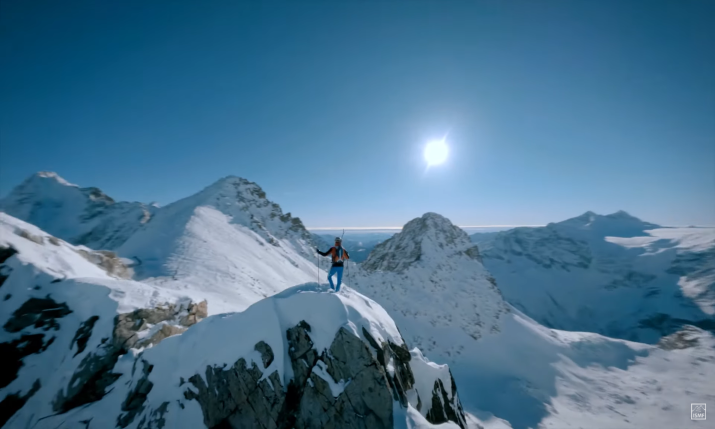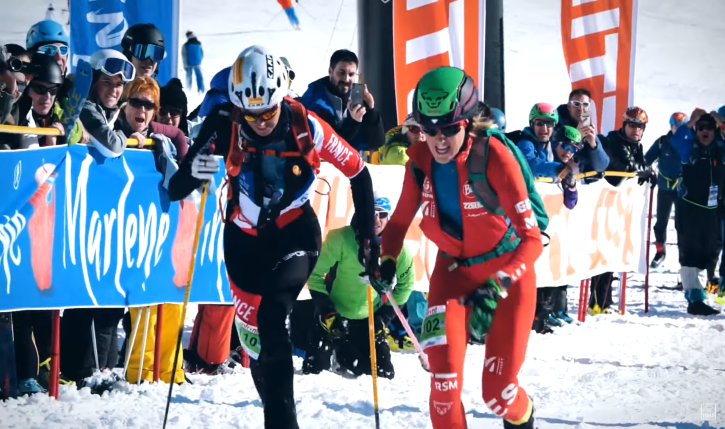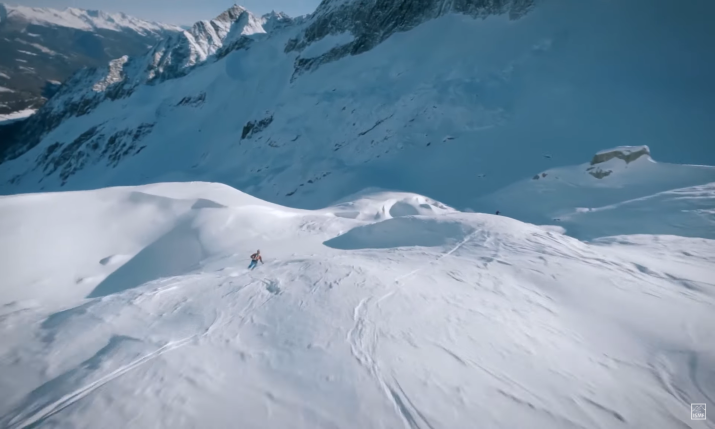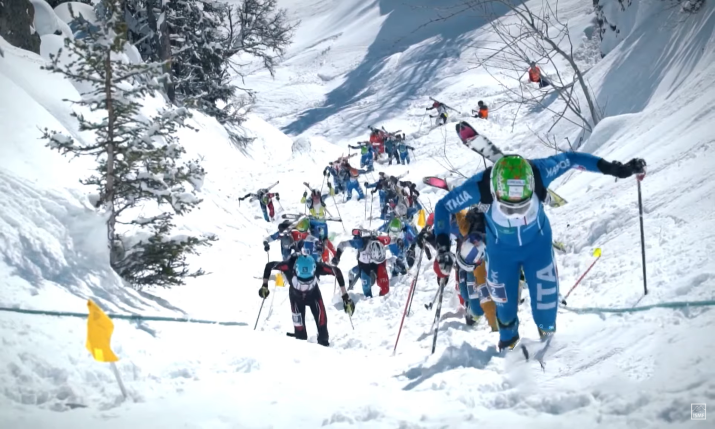Eurovision Sport to transform ski mountaineering into a fan-focused cloud-based remote production ahead of Winter Olympics 2026

Eurovision Sport is working with the International Ski Mountaineering Federation (ISMF) to turn the niche sport of ski mountaineering into an Olympic-ready discipline in time for the Winter Games in Milano Cortina in 2026. The EBU division is looking to repeat the success it achieved with the biathlon, governed by the International Biathlon Union (IBU), where, over several decades, it helped make an obscure military snow sport into one of the most popular Winter Olympic events. The new partnership will see Eurovision Sport and the ISMF re-shape ski mountaineering in an effort to make it into a household name.
Eurovision Sport struck a five-year host broadcaster agreement with ISMF which began last year from the start of the 2021-22 season. It is now in the middle of its initial season with ISMF, developing the sport itself, creating a pilot media platform – ISMF TV – and testing technologies to enable the sport to grow and hit the snow at the Winter Olympics 2026 with skis ready.
From biathlon success to ski mountaineering splendour
Franck Choquard, head of content and platforms at Eurovision Sport, told SVG Europe about the origins of its relationship with the ISMF: “The EBU, being the largest broadcaster’s association worldwide, is representing most of the public service media in Europe. We have a lot of mandates from advocacy technology and content to really help public service media and support public service media.
“On the sports side, we have a clear mandate of securing premium rights sporting properties on behalf of our membership, so we have more than 60 contracts with all kinds of sport in Europe and worldwide. On the winter sports side, we have a very, very strong relationship and portfolio with biathlon, our number one winter sport of cross country skiing and shooting, both in terms of reach and value.
“We have to think innovatively when we want to do this kind of sport live because first of all, the format is difficult, and it’s in the wild so you might not have the technology to produce it live because you don’t have the resources. You need to balance all of that”
“We have just tenured with biathlon a new eight-year agreement, starting next year,” he continues. “That’s the sport that we are particularly proud of because we started working with them 25 or 30 years ago; it was a military sport and quite unknown. Now it has become the number one winter sport by far in terms of rights value, in terms of visibility in key markets, such as the Germany, Nordics, and so on.”
Now the EBU is looking to do for ISMF what it has done for the biathlon. “When we look at ISMF and ski mountaineering, our ambition would be to repeat this success story and to be able to say in a few years’ time, “look where we started from, and now where we are”.”
He explains how Eurovision Sport began working with ISMF: “We were approached by ISMF following the announcement of their participation to the next Winter Olympic Games [Milano Cortina 2026] as a new Olympic sport, in terms of how we could help them to grow and to become, let’s say, more visible, more present, and how we can help them to prepare the step forward to become an Olympic sport in four years’ time.
“Our ambition is that by the time of the Olympics, to have reached a certain number of broadcast partners, and showcasing the sport on linear TV and on digital channels at the same level that we are covering other winter sports today,” he states.

Eurovision Sport is working with ISMF to transform the sport in time for the Winter Olympics 2026
Translating events in the wild into TV-friendly formats
ISMF events currently consist of Individual, Vertical, Sprint, Long Distance Team, and new for the 2026 Olympics, Mixed Relay. Currently some of the ISMF competitions are hard to translate to the world of live television. Choquard says the Individual race is particularly challenging as competitors set off onto the wilds on a mountain where there is no connectivity at all, yet as a nascent live TV event, the resources are not available for expensive solutions such as aerial relay helicopters. This means that Eurovision needs to be creative and innovative in its approach.
Notes Choquard: “We have to think innovatively when we want to do this kind of sport live because first of all, the format is difficult, because it’s quite long and we need to find a way to film it, and it’s in the wild so you might not have the technology to produce it live because you don’t have the resources. You need to balance all of that.
“There are some challenges to be addressed but we have already made a lot of progress. We started the journey back in early December with the first two races we did live in Italy. Since then, we’ve done an additional six races live. So now we really have a good system in place, and we will have three more races to do between now and the end of the season. Then we’ll start building the progression for the coming season, while in parallel, together with ISMF, we need to build up some of the Olympic formats; the Mixed Relay which is part of [the ISMF’s] commitment toward the IOC.”
At the Olympics the ISMF will present five events: two Individual – men and women – two Sprints – men and women – and the Mixed Relay. Adds Choquard: “For the first time, two weeks ago, we did all together the first Mixed Relay, both in terms of sports organisation, TV coverage, and so on. So all of that makes this kind of a challenge to develop in time for the 2026 Winter Olympics.”
He continues: “For us, it’s really about how do we help the sport to adapt from where it is today to how to become something more media savvy and able to adapt to what will be the reality when it reaches the Olympic Games; being able to stick to timing, to have a certain clarity on certain process. And how we also adapt some of the sports competition format to make it more spectacular for TV; shorter, more condensed, and so on, and working together on various strategies to do so.”

All alone on a mountain top…. apart from the Eurovision Sport camera crew, that is
Preparing for cloud-based trials at the World Cup
Choquard says it is challenging to adapt a historical sport to include TV-friendly formats of events under one hour long from beginning to the medals, where viewers can easily understand the philosophy, rules and goals of the sport, and for it to be exciting, but to also bring the flavour of the event – be that the nature and beauty of the mountains in the Individual or the thrill of a three minute downhill race in the Sprint – to the screen.
Yet he says: “This is what we are looking at building and developing. We have ongoing discussion for a lot of possibilities around that. It’s a heavy workload, but we are quite excited to look at all of it. We have discussions with the ISMF sport director to review some of the Sprint rules to make it even more spectacular and more TV-friendly, and we’re hoping to get to a more generic audience for that because we got very positive feedback from our media partners on the excitement the competition can bring.”
“Sustainability is important for the sport, and that’s why cloud-based production has come into the equation; first of all, it fits the sport very well in terms of what needs to be achieved, and then it ticks the boxes of both being innovative and sustainable”
He goes on: “We are already starting preparations for next season with ISMF in that respect, to make the Sprint even more spectacular – which will be the core live TV product – in parallel with what we are bringing on board which is more and more innovative and sustainable cloud-based solutions to be able to showcase what can be done in terms of hybrid cloud production, in terms of sustainability around this sport,” says Choquard.
As part of the immediate preparations for next season, which begins in November 2022, Eurovision Sport is arranging a showcase of cloud technologies to enable technology providers to demonstrate how they can enable the host broadcaster’s goals for the ISMF, as well as showing sports organisers what can be achieved with a new broadcast approach. It is hoped the trial will take part on or around the final World Cup event of the ISMF season, Flaine 2022 on 6 April in France.
Choquard comments: “In Flaine we will have three races, the Individual, the Vertical, and the Sprint. Around that we will have a hybrid set up, because right now we work with a lot of cloud-based contribution, FRT, bonding devices, and so on; we are testing various models to see what will fit well for the sport. We still have a gallery on site, a small mixer and so on, but the ambition is from next year onwards for those broadcasting teams to be cloud-based. So what we’ll be doing in Flaine is we’ll be inviting various types of cloud-based software as a services (SaaS) providers to showcase what could be done. We already have done a bit of testing around a couple of partners and we’ve seen the pro and cons, but for us, [cloud and remote production are] clearly one area where we want to go.”

Sustainability and making the most of the live sport
Until last season the ISMF had an agreement with another agency for a strategy built mostly on news and highlights clips. This is because, says Choquard, “it’s a very complex sport to produce live”.
He goes on: “But that strategy was triggering a very limited visibility. So what we built our strategy on was two pillars. First of all, we looked at what is the DNA of the sport? And the DNA of the sport is about sustainability. We really want to develop a very strong sustainable approach, including on production, and hope to reach – by the time we get to [the Winter Olympics 2026] – us having the number one sustainable Winter Olympic sport, because it’s very important for [the ISMF and it is very important for us.”
Sustainability is at the heart of the EBU, and therefore Eurovision Sport. Notes Choquard: “Everything we do, or aim at doing, has sustainability in mind; how we can make sure that it’s easy to organise for various local [Olympic] organising committees, that we don’t need a huge footprint, that the TV side of it is very easy for them to absorb and therefore, how we can work in new ways. For us, that’s why we trigger a lot [of conversations] on cloud-based exploitation. We really want, on the broadcast side where we have an impact, by [the time of the Winter Olympics 2026 that we will] be a 100% cloud-based production around this type of event.
“Right now the ambition is successfully integrating the ISMF into the Olympic Games, because that’s quite the challenge for a federation of this size,” he goes on. “Sustainability is important for the sport, and that’s why cloud-based production has come into the equation; first of all, it fits the sport very well in terms of what needs to be achieved, and then it ticks the boxes of both being innovative and sustainable.”
From niche sport to Olympic sport
After the first pillar of sustainability, the second is shaping ski mountaineering for live TV. Choquard explains: “The second pillar is, because we are in a niche sport that will become an Olympic sport in four years’ time, we really want to build the community factor and to exploit the live sport. It cannot be that now we only promote the sport with news clips and highlights; we all know the market today, and it needs to be live. We needed to build an approach where we could create a live digital-first experience.”
He continues: “We decided to produce some of the events live digitally, so using a lot of cloud-based solutions because we cannot run cables up mountains and we cannot have this huge footprint, and we were keeping a kind of more social media and ENG strategy for some of the races. We started building in this way and ISMF found it very attractive in order to interact and connect with the community,” Choquard notes.
To kick off this vision of remote cloud-based production, Choquard immediately bought in Flowics to develop the broadcast graphics, which will be important in engaging viewers and explaining the sport. “We really wanted a cloud-based partner that was good enough and flexible enough to grow with us around this project. We are very happy with what we’ve done with Flowics; the graphics side is really working well. We were able to develop an operating system over a very short time window. It still needs to improve, but we had something like six weeks to create a full live graphic system, connected to the timing and data of the sport to be able to be live. We achieved that at the end of last year thanks to our team and Flowics’ support. Now, we will make that grow and we’ll see a lot of added value to continue the journey. Now we want to interconnect that into the live mixing part. I’m quite positive that by next season we can be 100% cloud-based.”
Eurovision Sport has also been promoting the sport through its EBU membership. Says Choquard: “We don’t want to produce content only to be seen on what we’ve built, which is the ISMF TV platform, ISMF Live [the federations own over the top (OTT) platform which will continue to be developed]. We want to bring in media partners. And so we have been able to secure important territories such as France, Italy, Spain, Norway, Poland, and Switzerland, and we have started discussions with other members where [broadcast partners are interested in] publishing on their own digital platform and enriching the content with commentary, interviews, and so on.”
Take up has been faster than anticipated, with two EBU members broadcasting the last two ISMF events live on sports channels to test it on their audiences.
Choquard concludes: “We already have a lot of very positive feedback, more than what we thought we would have after half of the first season working with the ISMF, so, we are very positive.”
Production details
Eurovision Sport’s production set up has three levels, with subsequent content made available to media partners, the organisers and sponsors (as per respective rights):
Live TV product around Sprint and Relay races with 10 camera production with a mix of:
- 4G bonding technology
- PTZ cameras cabled (with fibre) to the gallery
- PTZ cameras using SRT or NDI contribution through public internet
- Drone filming
- Currently the live mixing is done on site using a small fly pack while the transmission being done using SRT technology both in 1080i50 and 1080p25
- Graphics are produced using cloud-based solution from Flowics
Digital TV product around some Vertical and Individual races:
- Similar set up for Sprint and Relay in term of camera numbers, but none of them are cabled to the gallery as the events take place too far away
- Using either bonding and/or SRT over VLAN/public internet
- ENG coverage for news and highlights
